
How to Use 4 Channel Relay Module: Examples, Pinouts, and Specs
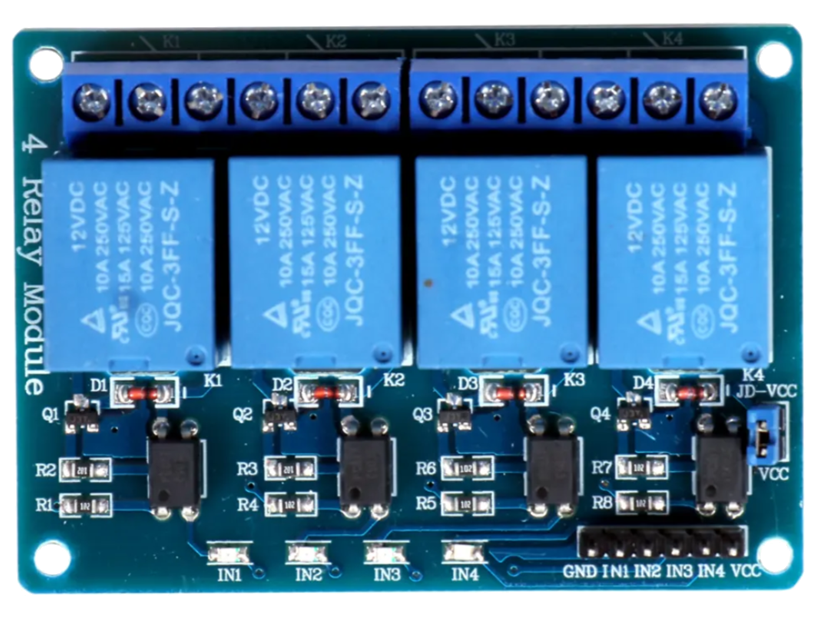
 Design with 4 Channel Relay Module in Cirkit Designer
Design with 4 Channel Relay Module in Cirkit DesignerIntroduction
The 4 Channel Relay Module is an electronic component designed to control multiple high-voltage devices using low-voltage signals. It features four independent relays, each capable of switching AC or DC loads. This module is widely used in home automation, industrial control systems, and IoT projects, where it enables safe and efficient control of high-power devices such as lights, fans, motors, and appliances.
Explore Projects Built with 4 Channel Relay Module
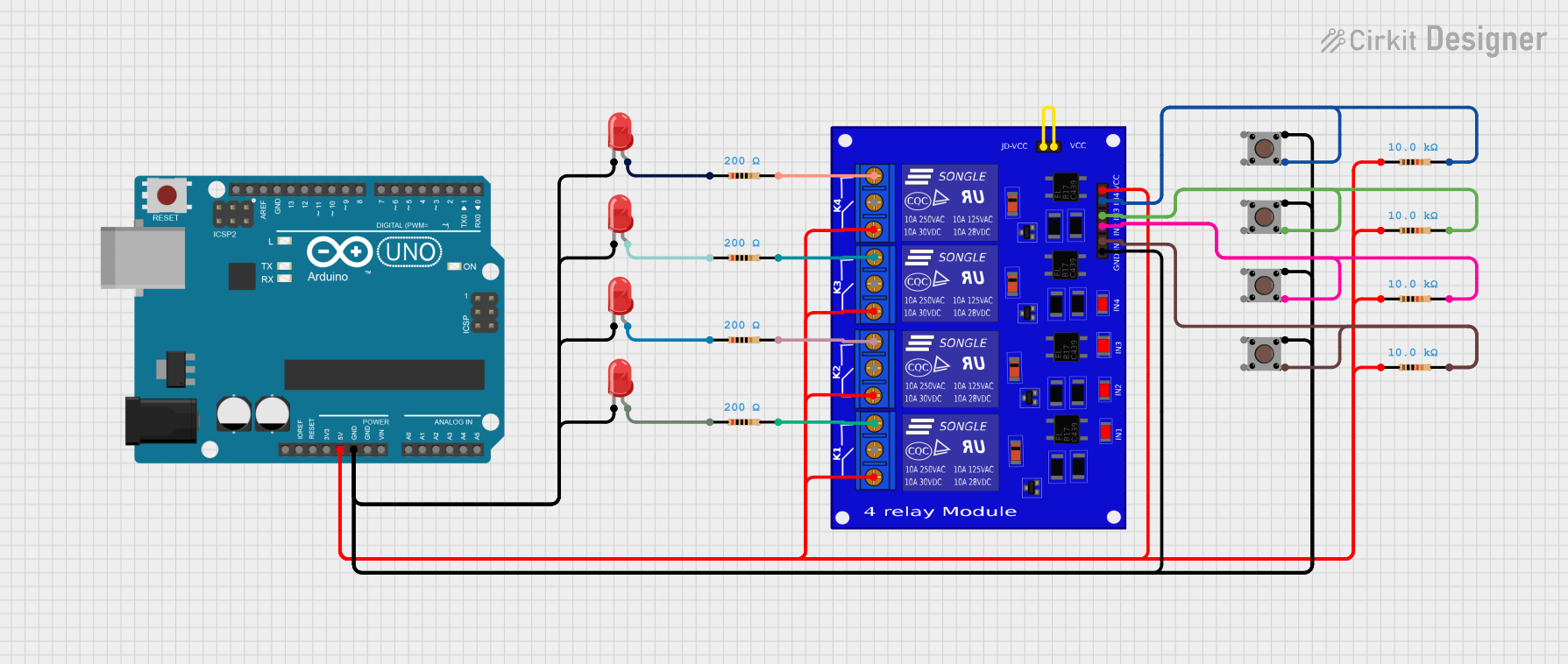
 Open Project in Cirkit Designer
Open Project in Cirkit Designer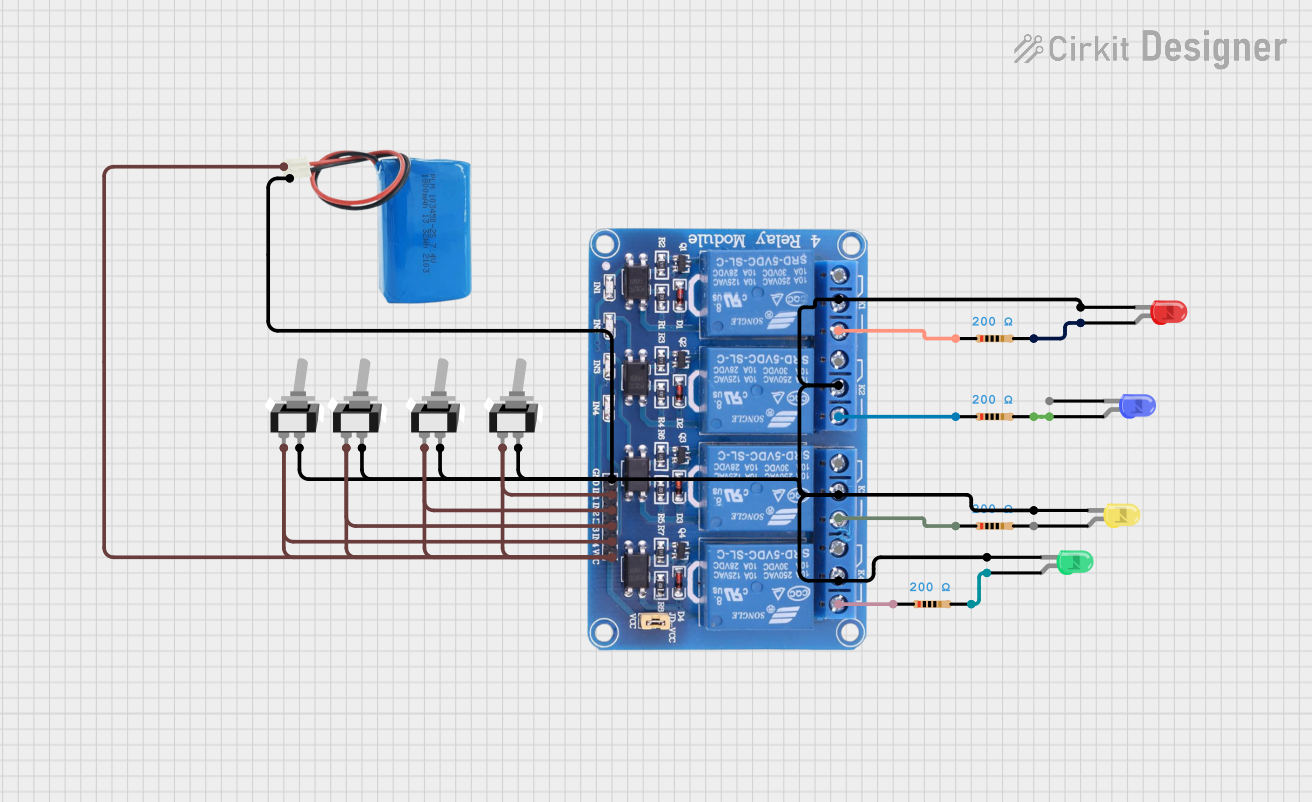
 Open Project in Cirkit Designer
Open Project in Cirkit Designer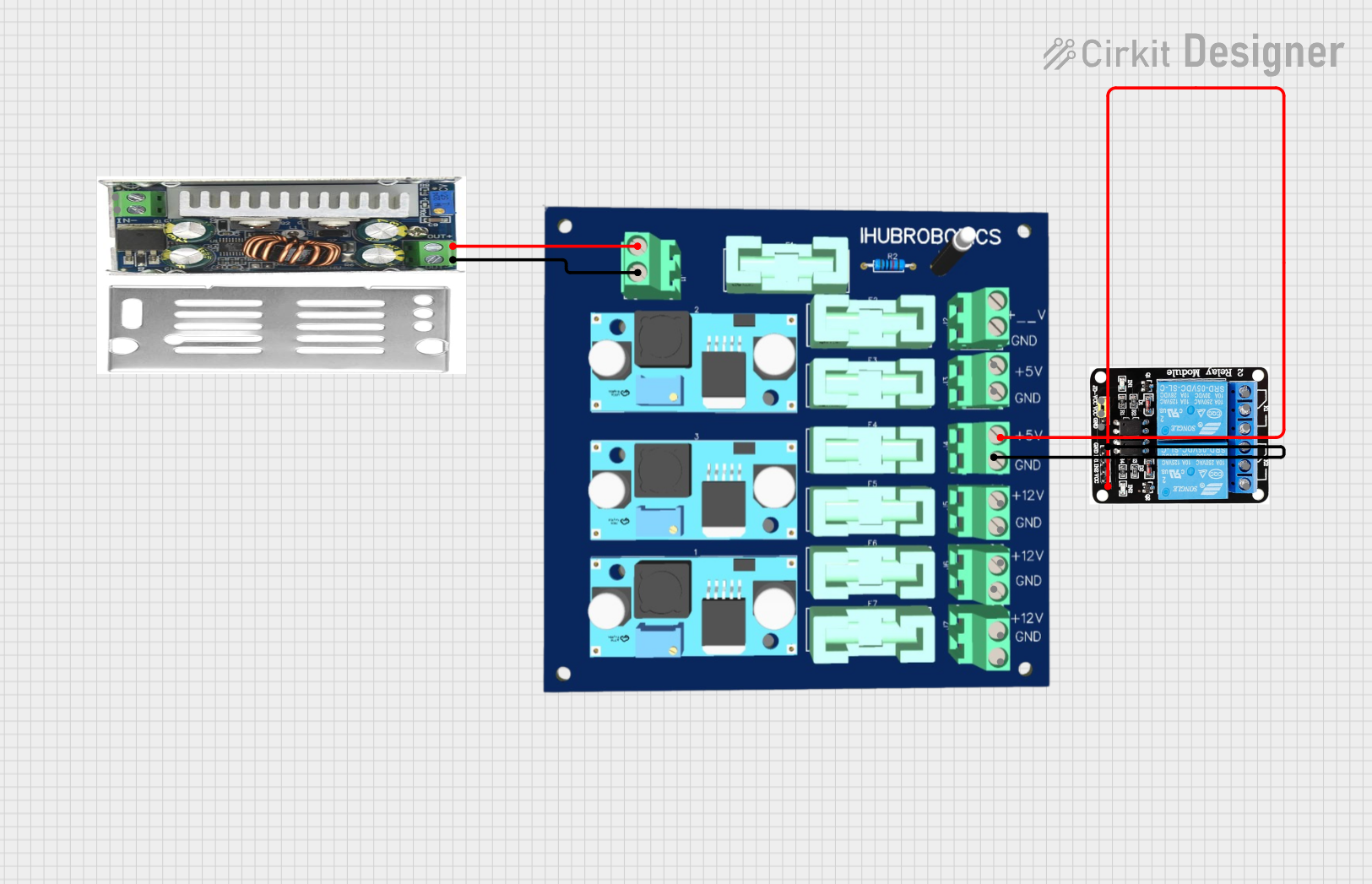
 Open Project in Cirkit Designer
Open Project in Cirkit Designer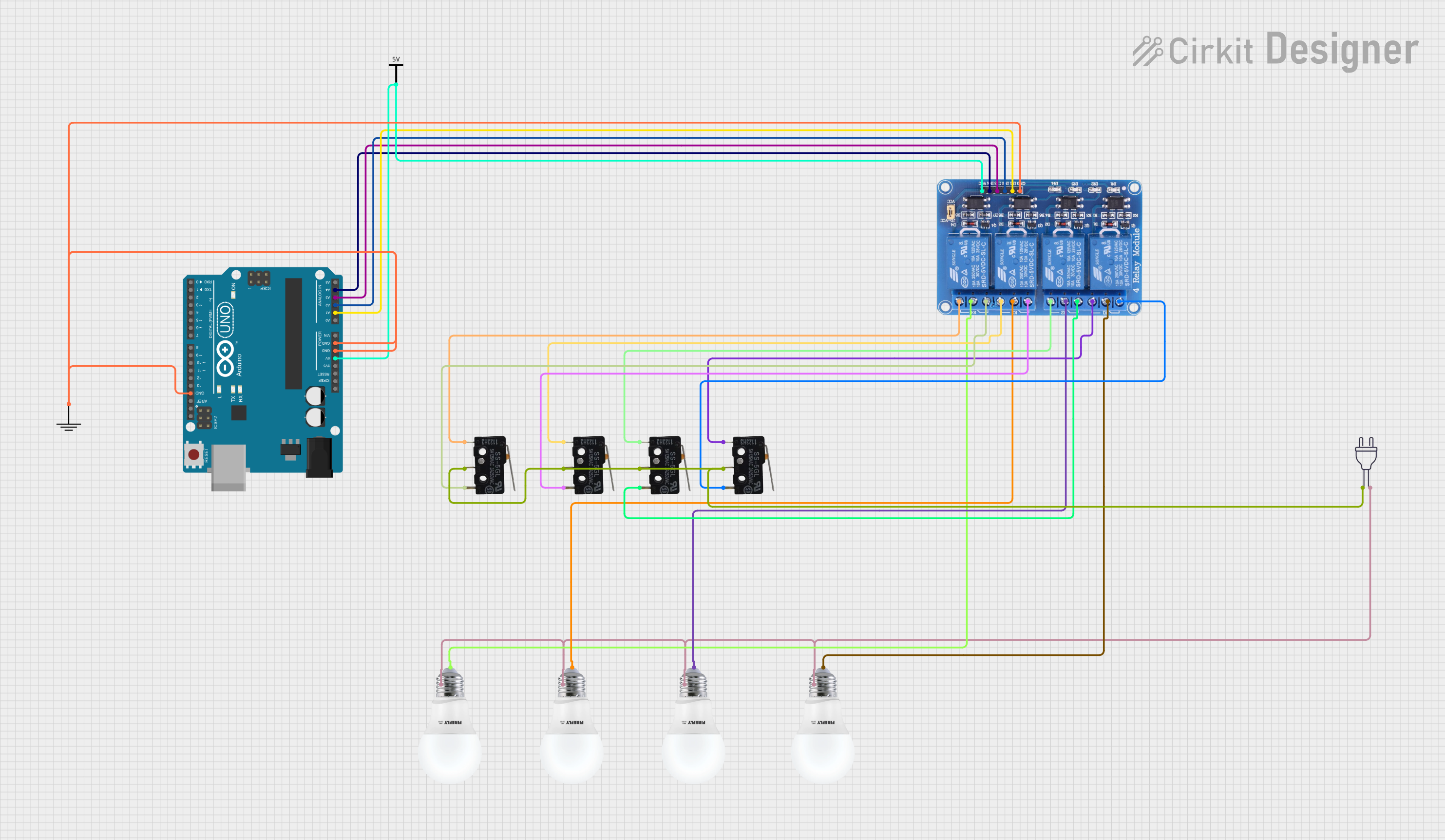
 Open Project in Cirkit Designer
Open Project in Cirkit DesignerExplore Projects Built with 4 Channel Relay Module

 Open Project in Cirkit Designer
Open Project in Cirkit Designer
 Open Project in Cirkit Designer
Open Project in Cirkit Designer
 Open Project in Cirkit Designer
Open Project in Cirkit Designer
 Open Project in Cirkit Designer
Open Project in Cirkit DesignerCommon Applications and Use Cases
- Home automation systems (e.g., controlling lights or appliances remotely)
- Industrial equipment control
- IoT projects for smart device integration
- Robotics and automation
- Prototyping and testing circuits with high-power loads
Technical Specifications
Key Technical Details
- Operating Voltage: 5V DC
- Trigger Voltage: 3.3V to 5V (compatible with most microcontrollers)
- Relay Type: SPDT (Single Pole Double Throw)
- Maximum Load:
- AC: 250V at 10A
- DC: 30V at 10A
- Isolation: Optocoupler isolation for safe operation
- Indicator LEDs: One LED per relay to indicate activation
- Dimensions: Approximately 75mm x 55mm x 20mm
Pin Configuration and Descriptions
The 4 Channel Relay Module has two main sections: the input pins for control signals and the output terminals for connecting the load.
Input Pins
| Pin Name | Description |
|---|---|
| VCC | Power supply input (5V DC). |
| GND | Ground connection. |
| IN1 | Control signal for Relay 1 (active LOW). |
| IN2 | Control signal for Relay 2 (active LOW). |
| IN3 | Control signal for Relay 3 (active LOW). |
| IN4 | Control signal for Relay 4 (active LOW). |
Output Terminals (for each relay)
| Terminal | Description |
|---|---|
| COM | Common terminal for the relay. |
| NO | Normally Open terminal (connected to COM when the relay is activated). |
| NC | Normally Closed terminal (connected to COM when the relay is deactivated). |
Usage Instructions
How to Use the Component in a Circuit
- Power the Module: Connect the VCC pin to a 5V DC power source and the GND pin to ground.
- Connect Control Signals: Use a microcontroller (e.g., Arduino UNO) to send control signals to the IN1, IN2, IN3, and IN4 pins. A LOW signal activates the corresponding relay.
- Connect the Load:
- Identify the device you want to control (e.g., a light bulb or motor).
- Connect one terminal of the device to the relay's COM terminal.
- Connect the other terminal to either the NO or NC terminal, depending on whether you want the device to be ON or OFF by default.
- Test the Circuit: Power the module and send control signals to verify the relays switch as expected.
Important Considerations and Best Practices
- Isolation: Ensure proper electrical isolation between the low-voltage control side and the high-voltage load side to prevent damage or hazards.
- Power Supply: Use a stable 5V DC power source to avoid erratic relay behavior.
- Load Ratings: Do not exceed the maximum load ratings of the relays (250V AC/10A or 30V DC/10A).
- Active LOW Logic: Remember that the relays are activated by a LOW signal on the input pins.
- Heat Dissipation: If switching high-power loads, ensure adequate ventilation to prevent overheating.
Example Code for Arduino UNO
// Example code to control a 4 Channel Relay Module with an Arduino UNO
// Define the relay control pins
#define RELAY1 2 // Pin connected to IN1
#define RELAY2 3 // Pin connected to IN2
#define RELAY3 4 // Pin connected to IN3
#define RELAY4 5 // Pin connected to IN4
void setup() {
// Set relay pins as outputs
pinMode(RELAY1, OUTPUT);
pinMode(RELAY2, OUTPUT);
pinMode(RELAY3, OUTPUT);
pinMode(RELAY4, OUTPUT);
// Initialize all relays to OFF (HIGH state)
digitalWrite(RELAY1, HIGH);
digitalWrite(RELAY2, HIGH);
digitalWrite(RELAY3, HIGH);
digitalWrite(RELAY4, HIGH);
}
void loop() {
// Example sequence to toggle relays ON and OFF
digitalWrite(RELAY1, LOW); // Turn ON Relay 1
delay(1000); // Wait for 1 second
digitalWrite(RELAY1, HIGH); // Turn OFF Relay 1
delay(1000); // Wait for 1 second
digitalWrite(RELAY2, LOW); // Turn ON Relay 2
delay(1000); // Wait for 1 second
digitalWrite(RELAY2, HIGH); // Turn OFF Relay 2
delay(1000); // Wait for 1 second
digitalWrite(RELAY3, LOW); // Turn ON Relay 3
delay(1000); // Wait for 1 second
digitalWrite(RELAY3, HIGH); // Turn OFF Relay 3
delay(1000); // Wait for 1 second
digitalWrite(RELAY4, LOW); // Turn ON Relay 4
delay(1000); // Wait for 1 second
digitalWrite(RELAY4, HIGH); // Turn OFF Relay 4
delay(1000); // Wait for 1 second
}
Troubleshooting and FAQs
Common Issues and Solutions
Relays Not Activating:
- Ensure the module is powered with a stable 5V DC supply.
- Verify that the control signals are correctly connected and configured as active LOW.
- Check for loose or incorrect wiring.
Erratic Relay Behavior:
- Use a decoupling capacitor near the VCC and GND pins to stabilize the power supply.
- Ensure the microcontroller's ground is connected to the module's ground.
Load Not Switching:
- Confirm that the load is connected to the correct relay terminals (COM, NO, or NC).
- Verify that the load does not exceed the relay's maximum ratings.
Overheating:
- Avoid switching loads near the relay's maximum current rating for extended periods.
- Provide adequate ventilation or cooling if necessary.
FAQs
Q: Can I use this module with a 3.3V microcontroller like the ESP8266?
A: Yes, the module is compatible with 3.3V control signals, but ensure the relays are powered with 5V.
Q: Is it safe to switch high-voltage AC loads with this module?
A: Yes, but ensure proper insulation and follow safety guidelines when working with high-voltage circuits.
Q: Can I control all four relays simultaneously?
A: Yes, you can activate all four relays at the same time, provided the power supply can handle the current draw.